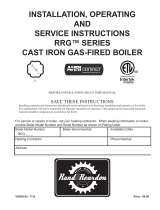
POP SAFETY VALVE
The pop safety valve should open automatically if the boiler
steam pressure exceeds the pressure rating of the valve (15
psig). Should it ever fail to open under this condition, shut
down your boiler. If valve discharge occurs, or valve fails
to open as described above, contact an authorized contractor
or qualified service technician to replace the pop safety valve
and inspect the heating system to determine the cause, as
this may indicate an equipment malfunction.
Run a p_pe from the safety valve outlet (pipe must be same
size as outlet and open end must not be threaded) to an
open drain, tub or sink, or other suitable drainage point not
subject to freezing. Failure to do so may cause Water damage
or injury should relief valve release Do not cap off the drain
line from this valve!
STEAM PRESSURE GAUGE
Every system should have a pressure gauge installed in the
boiler. This gauge enables you to monitor the pressure in
the system. If the safety devices fail to shut off your boiler
at the proper settings, notify your serviceman immediately
WATER LEVEL GAUGE
The water level in the boiler can be seen through the glass
tube in the water level gauge at side of boiler. Correct cold
boiler water revel is stamped on side jacket panel. The water
level should be checked regularly for the proper level.
On the right side jacket panel of the boiler, there are three
holes for the glass water level gauge. The top hole is common
for both types of low water cut off, and is used for the upper
gauge glass fitting. The middle hole, 9" down from the top
hole, is used for the bottom gauge glass fitting for the Model
67D-1 and 47-2 float type low water cut off. The lowest hole,
12V4"down from the top hole, is used for the bottom gauge
glass fitting for the Model PS-802 probe type low water cut
off. The hole that is not being used is covered with a sheet
metal knockout.
STEAM PRESSURE CONTROL
The steam pressure limit control {pressuretrol) shuts off the
gas to the main burners when the steam pressure in the
boiler reaches the cut-off setpoint (i.e. the sum of the cut-
in and the differential setpoints). Burners retire when the steam
pressure drops to the cut-in setpoint. System pressure
requirements are based on the size and condition of the
pipes, and the load.
LOW WATER CUT-OFF
1 Model 67D-1
This is a float operated switch which shuts down the gas
burner if water falls below the visible bottom of the gauge
glass.
2. Model PS-802
This is an electronic probe type LWCO. The probe is
located inside the boiler. The LWCO will shut down the
burners if the water loses contact with the probe for a
period of 10 seconds.
Refer to manufacturer's instructions {enclosed) for more
information.
WATER FEEDER (Optional)
The Model WF-2U-24 water feeder may be used with either
of the available low water cut-offs. The water feeder's job
is to maintain a safe minimum water level It's used to
keep the boiler running by compensating for minor
evaporative steam leaks, and to prevent freeze-ups if the
homeowners are away and a return line should spring
a leak.
McDonnell and Miller Model 101 water feeders may be
used, however the water feed rates are too high and need
to be regulated or throttled, and wiring will have to be
revised. Consult the boiler manufacturer before using these
or any other non-standard types of controls.
The automatic water feeder is a safety device, not a
convenience item. It is not designed to maintain a "normal"
water line. The water feeder does not take the place of
a responsible person monitoring and maintaining the
normal water line. Steam boilers require personal attention.
VENT DAMPER
This is an automatic, motorized stack damper that has
been developed to increase the efficiency of heating
systems by reducing standby losses from the boiler end
the conditioned air space. The damper closes the chimney
vent when the burner is off and fully opens it when
combustion is required.
ROLLOUT SWITCH
(FLAME ROLLOUT SAFETY SHUTOFF)
The rollout switch is a temperature-sensitive fuse link
device. It is located on the boiler base just outside the
fire box. In the event of heat exchanger flueway blockage
causing flame to roll out of the fire box, the fuse will blow,
shutting down the flow of gas to the main burners. The
fuse does not change in appearance when blown.
If the rollout switch blows, it must be replaced with an
exact replacement. Check heat exchanger flueways for
blockage when restoring system to operating condition.
Do not operate system without a rollout switch.
SPILL SWITCH
(BLOCKED VENT SAFETY SHUTOFF)
The spill switch is a manual reset disc thermostat with
a fixed setpoint (280 ° F), and normally closed contacts.
It is located at the relief opening of the draft diverter. In
the event of chimney or venting system blockage causing
products of combustion to spill out of the relief opemng,
the spill switch disc heats up and the spill switch contacts
will open, shutting down the flow of gas to the main burners
by removing power to the gas valve.
In the event that the spill switch contacts open, the reset
button on the back of the switch will pop up. The spill
switch must be reset manually, after the switch has cooled
off, by pushing the reset button down. Check the venting
system and chimney for blockage when restoring the
system to operating condition. DO NOT operate the boiler
without a spill switch.
1 9 7_ISH




















